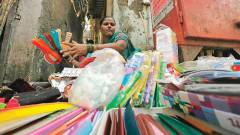“Knowledge first” is the corporate mantra of the company I work for – Motilal Oswal Financial Services Ltd. Amongst the various knowledge-sharing initiatives of the company, one involves bringing senior leaders from corporate India to come and share their learnings and experiences. Corporate leaders bring valuable insights which their companies’ annual reports would not often contain. One of the recent guest speakers under this initiative was Mr Sanjiv Mehta, the CEO and MD of Hindustan Unilever. Sometimes it is insightful to look at the FMCG consumption story from the supplier’s perspective rather than buyer’s, as to how suppliers can deepen their reach into hitherto under-penetrated regions. His thoughts and unique insights into marketing strategies and consumption demand set my mind thinking on an observation which I had made in Bangladesh in 2005.
Back in 2005, I did an internship project with Grameen Bank, the global pioneer in microfinance. I had to make field visits into Bangladesh’s rural districts to visit branches, SHG meetings and borrowers’ business establishments to get a ground-level understanding. One of the most interesting aspects was seeing the various activities for which the women borrowers took their loans. Not only the nature of the activity itself, but also the thought-process that they put while deciding on an activity and making it successful as well as their progression over time in terms of the profile of their businesses. What had started with small-scale farming and artisan activities was making way for small-scale trading and production activities.
One of the activities gaining serious ground was that of establishing and running modern grocery stores in the villages by microfinance borrowers. It was an eye-opener to see that many villages in rural hinterlands still do not have properly-run grocery stores which sell an array of packaged products across segments and shelf-life, something that urban folk take for granted. This was where microfinance seemed to be making its mark, by facilitating the supply of modern packaged products (FMCG/CPG goods) to village buyers through stores that were set up with microfinance borrowers, and thus, deepening the reach of the FMCG companies into the rural areas – a win-win situation.
I had to visit the business establishments of borrowers and in this case, it was the stores. I visited borrowers’ stores in districts like Narayanganj, Barisal, Rangpur, etc, and I now recall some of the observations the women running those stores told me.
The first was on demand. It is not that stores did not exist before. Stores were there, but often they were run-down shambles where products got damaged, most did not stock the latest products and storage was an issue for freshness. This was a time when awareness of urban consumption was reaching rural areas due to advertising in television, highway hoardings, and mobiles. Thus, the demand was there, something for which the existing stores seemed slow to change.
Another aspect was the demand potential. Most villages could house a couple of such new grocery stores, depending on its physical geographic spread. In villages where most dwellings were physically located around a closer navigable area, the potential of additional stores was lower as people in outlying areas could reach the store easily. In villages which were physically spread out, there would be chance to open new stores, but that would depend on the population in each catchment area.
Store locations were typically around the village-centre, where people typically gather in villages. Locations were also in areas where the main connecting highways met. This was where people waited for long-distance buses and saved the time to go till the bus station.
Depending on the frequency of buses, such road intersection spots were sweet spots. The highway network and bus frequency in Bangladesh was in fact better than most of India at that time. This would mean that the waiting time for passengers there was lower than that in India. But even then, that waiting time seemed enough to justify the setting up of the store to cater to those waiting.
Another was the utilisation of the loan. Unlike most microfinance loans, the nature of this activity had more to do with working capital loans to buy the inventories. Purchase of refrigerator or cooling cabinets was the only equipment in terms of capital purchase. As per borrowers, their cash cycle ran smoothly. Most were cash purchases since the buyers were eager to get the new FMCG products due to the novelty factor. Even in cases of sale on credit, it depended on the comfort level with the buyer. The Self-Help Group model of microfinance was useful when it came to influencing the local community to honour credit, since many of them were also part of self-help groups under the same microfinance umbrella in that village.
Grocery stores were useful in terms of engaging family members productively, wherein the borrower could put effort into another activity at the same time. There was restriction on additional loans a borrower could get when a loan was still outstanding. However, she could help another borrower from her family in their activity in terms of mindshare/effort, while manning the store at the same time.
This meant additional income. Typical cases included a Xerox business or garment sewing business, along with the store. Ticket sizes were in line with average microfinance loans. Loans were progressive, starting small and thereafter, progressing to higher amounts once earlier loans were paid off. The main challenge was the rental of the location itself, since it meant earning enough to pay off the weekly installments, as well as the rent for a crème-de-la-crème location.
Microfinance certainly seemed to have played a role in deepening the rural reach of FMCG products in Bangladesh. During a visit to a leading local stockbroker – LankaBangla Securities – it turned out that the consumer sector was a prominent component along with the banking and industrial sectors. Success stories of microfinance and modern grocery businesses are abound not only in Bangladesh, but also with leading microfinance firms in Pakistan, Philippines, Ghana, Kenya, India, Mexico, Uganda, Afghanistan, and such.
The microfinance firm also often connects the women borrowers with wholesale suppliers, as in the case of Samgam store scheme of SKS Microfinance, the leading Indian microfinance player.
As microfinance penetrates further, creating economic opportunities in rural districts of developing countries through entrepreneurship, it should aid the penetration of FMCG companies with the increasing trend of modern grocery stores as a microfinance business activity. Proactive engagement of FMCG companies with microfinance firms and target borrowers would help unfold the rural consumption story to its true potential.
Source: Dhaka Tribune










